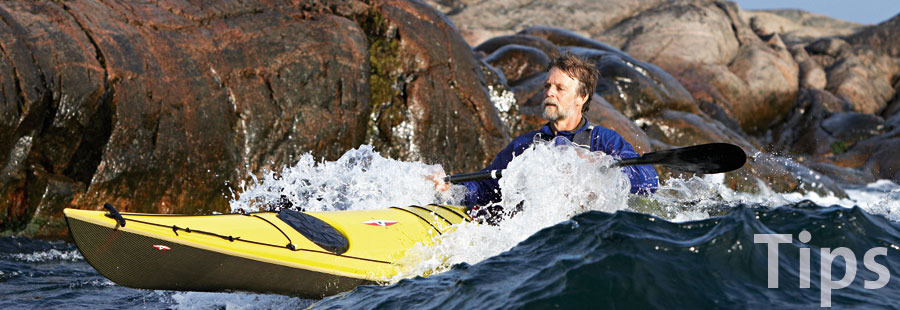Before embarking, stow your Blade Aid where it can be immediately accessed in case of need. Suitable locations can include secured under deck rigging but don’t just slip it under the bungee cords, clip it in. If conditions get rough enough to make its use possible or likely, they’re also rough enough to dislodge any gear slipped under the deck cords. Clip it in for security. This can be done by inserting one end of leash through a corner grommet and then inserting clipped end of leash through loop and clipping into bungee cord or deck fitting. An alternative is to stow it next to seat in cockpit. Again, don’t just stuff it in there, secure it by clipping it to a permanent part of your kayak. If a wet exit occurs, the seas washing into the cockpit can wash any unsecured piece of equipment out and away.
|
|
|
1. In event of a deep water capsize followed by a wet exit, first focus on control and containment of your kayak and paddle. Right your kayak and stick paddle down inside cockpit to free at least one hand. A paddle held in your arm pit is more likely to wash loose or at the least makes it awkward to manipulate the paddle float. Determine which side of the kayak is more protected from waves or chop and work yourself around to that side. Slide paddle float over blade of paddle extending from cockpit. Inflate float until float "locks" onto paddle blade by the expansion of the air chambers putting pressure on the blade from each side. Slide the paddle from the cockpit. Rotate the opposite blade so that it lays flat and insert the blade under the deck rigging behind your cockpit. This will stabilize your boat as the paddle/float combination results in an outrigger configuration. |
|
|
|
2. Re-enter your kayak from the side on which you have deployed the paddle float. Grasp the cockpit rim and hoist your self onto the deck, using the paddle and float to help support your weight by draping a leg over the paddle. |
|
|
|
3. Keeping low, rotate your body around on the deck until you are in a position to re-enter the cockpit legs first. |
|
|
|
4. With the float still deployed and if conditions allow, retrieve your bilge pump and pump out water that entered the cockpit while boat was upset. If conditions are exceptionally rough or seas sufficiently large, you may be required to first reattach your spray skirt before pumping. The situation may actually dictate that you attempt to paddle boat to calmer waters before pumping. This should be a last extremity as a kayak filled with water is extremely unstable. If this situation is encountered, you are far better off to use your spare paddle, leaving the paddle with float deployed for stability. Another option you might have is to stick the pump alongside your hip on leeward (side away from waves) side and reattach your skirt. Some skirt and cockpit combinations may make this impossible. If this is possible (and this is something you should determine before paddling), proceed to pump the cockpit dry to improve your control of boat. If your kayak is outfitted with a rudder, try using the rudder to keep the kayak nose (bow) on to wind and waves during this process. Good luck! |








